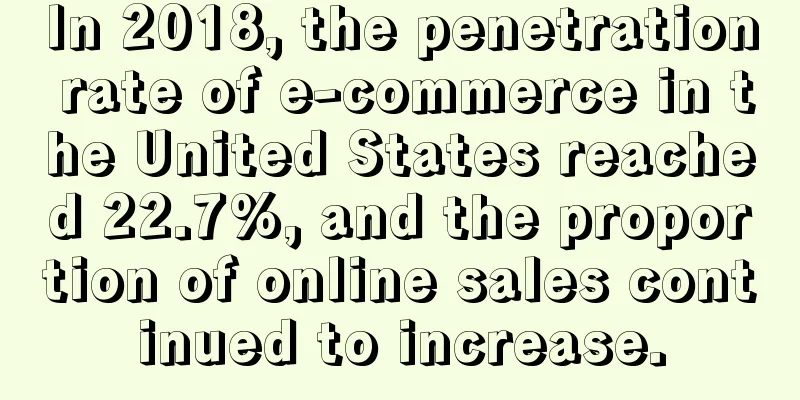In 2018, the penetration rate of e-commerce in the United States reached 22.7%, and the proportion of online sales continued to increase.

|
It is learned that on March 3, according to foreign media reports, according to Digital Commerce 360's analysis of US Department of Commerce data, the US e-commerce penetration rate will reach 22.7% in 2024, a new high. At the same time, e-commerce sales will increase to approximately US$1.2 trillion, more than double that of five years ago. It is understood that since the U.S. Department of Commerce began tracking e-commerce penetration in 2000, the proportion has increased almost every year. In 2022, the U.S. e-commerce penetration rate was 20.7%, a slight decrease from 20.8% in 2021. But by 2024, this proportion exceeded 22.7%, indicating that the share of e-commerce in the retail market continues to increase. Since 2020, e-commerce sales have always accounted for at least one-fifth of total U.S. retail sales, showing that online shopping has become an important choice for consumers. Image source: Digital Commerce 360 E-commerce sales are also growing significantly faster than the overall retail market. In 2024, U.S. e-commerce sales will grow by 7.5% year-on-year, more than twice the growth rate of total U.S. retail sales (2.6%) during the same period. Since the Ministry of Commerce began collecting relevant data, e-commerce sales have continued to grow every year without a decline. Even as the dividends from the epidemic gradually fade, the e-commerce industry has maintained steady expansion. Image source: Digital Commerce 360 In the long run, the growth momentum of the US e-commerce market mainly comes from multiple factors, including changes in consumer habits, the popularity of digital payments, and the continuous optimization of e-commerce platforms and logistics infrastructure. In 2024, e-commerce sales of approximately US$1.2 trillion doubled from US$571.09 billion in 2019, reflecting the profound impact of the e-commerce industry since the epidemic. In addition, e-commerce sales in 2023 increased by 7.5% year-on-year, which, although lower than the high growth level in the early 2020s, still consolidated the previous market expansion trend. As the penetration rate of e-commerce continues to increase, the competitive landscape of the US retail market will further tilt toward online in the future. Author ✎ Rayna/ Statement: This article is copyrighted and may not be reproduced without permission. If you need authorization, please contact: happy |
Recommend
What is an Amazon pop-up store? Amazon pop-up store review
A pop-up store is a brand guerrilla store that doe...
Many Amazon ASINs are banned from sale! A large number of sellers suffer huge losses!
Recently, sellers have reported that ASINs have b...
Amazon employees are on strike again! FBA delivery is massively delayed!
FBA is a service that Amazon is proud of. On the o...
The US "home improvement boom" is fading! Lowe's lowers its revenue forecast for fiscal 2022!
<span data-shimo-docs="[[20,"获悉,据外媒报道,近日家居...
Must-read | Six ways to quickly clear Amazon products
It is already July, but some sellers are still wor...
What is Ocean Freight? Ocean Freight Review
Ocean freight is broadly defined as all sea-relate...
What is Donghui Yuntong? Donghui Yuntong Review
Donghui Yuntong (Shenzhen Donghui Yuntong Internat...
Amazon Prime Day 2020 has been officially announced! You need to make these 4 preparations!
<span data-shimo-docs="[[20,"亚马逊于今日正式宣布,亚马...
Amid the wave of layoffs, Amazon made a net profit of tens of billions of dollars in a single quarter!
In 2023, the cross-border world is in turmoil. Fac...
I started my own business, but only received 3 orders in half a month for goods worth hundreds of thousands of yuan! I have been preparing for this product for more than half a year, is it all going to go to waste?
Anonymous user My C position My idea is that the c...
What is Dehengshun Supply Chain? Dehengshun Supply Chain Evaluation
Dehengshun (Shenzhen Dehengshun Supply Chain Manag...
What is Tomorrow Enterprise Management Co., Ltd.? Tomorrow Enterprise Management Co., Ltd. Review
Tomorrow Enterprise Management Co., Ltd. provides ...
Mason's container volume breaks 60,000! Freight forwarders make a lot of money, but sellers lose 1 million in a year?
Under the impact of the epidemic in 2020, cross-bo...
What is Lehu.com? Lehu.com Review
Lehu.com is currently a photo sharing website crea...
What is Amazon Go? Amazon Go Review
Amazon Go is an unmanned convenience store launche...









